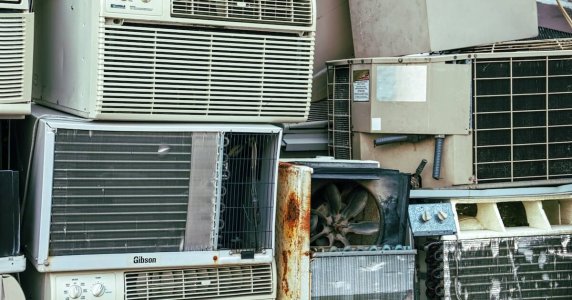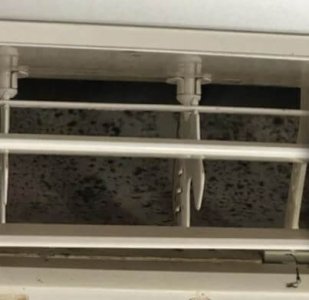Rental horror story: Tenant's shocking discovery inside air conditioning
- Replies 8
Being a tenant in Australia is no easy feat. On top of the rising rental prices and the lack of rental security, there are also reports of landlords taking months or even years to fix major issues inside rental properties.
And these are issues that can affect your health and safety severely if left unchecked.
This was exactly the troubling case a humble tenant found themself facing recently – and trust us, their nerve-racking story is one worth paying attention to.
Social media users across the country shouted back a resounding ‘NO’ to a tenant who was asking if they were ‘overreacting’ over what they found inside their air conditioning unit.
The renter posted a photo of the air conditioner to Facebook and showed the unit covered with dense mould inside its vents.
The tenant then went on to explain they had only recently moved into the rental property. They also shared they emailed their real estate agent to bring the issue to their attention after having no luck with a ‘repair man’. The tenant also admitted they stopped using their air conditioner out of fear that the mould would spread.
However, not using an air conditioner in the summer is dangerous, as temperatures soar as hot as 40°C inside homes. The World Health Organisation’s recommended safe limit is no higher than 25°C for more than nine hours daily.
Tenant advocacy organisation Better Renting tracked the temperature in 77 rentals across Australia between December 2022 and February this year. They found that for nine hours a day, people were above a safe temperature level on average.
People took to the comments to reassure the renter that they weren’t being unreasonable and that their air conditioner unit’s current state ‘should not be tolerated’.
One stated that the ‘real estate agency [should] organise to get the unit professionally cleaned’.
Another warned that leaving the unit in its current state could foster more mould to grow and spread around the house.
‘As someone who has their own business doing this, this is bad,’ one added before saying that professional cleaners need to remember why removing mould is so important.
‘It's people's health that is impacted here,’ they continued.
Professor of Microbiology Dee Carter said that despite it not being ‘uncommon’ to have mould growth in a house, ‘allergic-type responses’ can occur if mould is not removed properly. This can make people feel ill if left untreated.
‘Any amount of visible mould is not a good thing. Try to ensure there’s no visible mould in the house,’ Professor Carter said.
Mould growth was found on many houses along the east coast of Australia after the area was subjected to intense rainfall and flooding last year, which was caused by consecutive La Nina weather events.
Professor Carter shared that she herself was not immune to fungal growth in her property.
‘I got mould in my home during the severe weather in Sydney a year and a half ago,’ she said before adding that she had to combat mould growing on her books, table and inside her wardrobe.
Water exposure, alongside dust and improper ventilation, encourages mould to grow and removing it is critical for good health, Professor Carter revealed.
‘As you live with mould, it can start to become an issue, and if you’re not remedying it, it will only continue to grow.’
When mould grows indoors, it can cause a range of health issues and various adverse effects on the human body, ranging from mild to severe in intensity. These risks include irritation to the eyes, nose, and throat; breathing difficulties such as asthma attacks; chest tightness; headaches; skin irritation; fatigue; and similar flu-like symptoms.
It is highly important for those living in damp indoor environments to be aware of the health risks and potential effects of prolonged mould exposure. People with compromised immune systems, such as infants, children, the elderly, and anyone with known allergies, are most susceptible to the side effects of mould and may experience more severe reactions than healthy individuals.
 Members, do you have any mould removal/protection tips you would like to share with us? Do you have a rental horror story to tell us? Feel free to comment below!
Members, do you have any mould removal/protection tips you would like to share with us? Do you have a rental horror story to tell us? Feel free to comment below!
And these are issues that can affect your health and safety severely if left unchecked.
This was exactly the troubling case a humble tenant found themself facing recently – and trust us, their nerve-racking story is one worth paying attention to.
Social media users across the country shouted back a resounding ‘NO’ to a tenant who was asking if they were ‘overreacting’ over what they found inside their air conditioning unit.
The renter posted a photo of the air conditioner to Facebook and showed the unit covered with dense mould inside its vents.
The tenant then went on to explain they had only recently moved into the rental property. They also shared they emailed their real estate agent to bring the issue to their attention after having no luck with a ‘repair man’. The tenant also admitted they stopped using their air conditioner out of fear that the mould would spread.
However, not using an air conditioner in the summer is dangerous, as temperatures soar as hot as 40°C inside homes. The World Health Organisation’s recommended safe limit is no higher than 25°C for more than nine hours daily.
Tenant advocacy organisation Better Renting tracked the temperature in 77 rentals across Australia between December 2022 and February this year. They found that for nine hours a day, people were above a safe temperature level on average.
People took to the comments to reassure the renter that they weren’t being unreasonable and that their air conditioner unit’s current state ‘should not be tolerated’.
One stated that the ‘real estate agency [should] organise to get the unit professionally cleaned’.
Another warned that leaving the unit in its current state could foster more mould to grow and spread around the house.
‘As someone who has their own business doing this, this is bad,’ one added before saying that professional cleaners need to remember why removing mould is so important.
‘It's people's health that is impacted here,’ they continued.
Professor of Microbiology Dee Carter said that despite it not being ‘uncommon’ to have mould growth in a house, ‘allergic-type responses’ can occur if mould is not removed properly. This can make people feel ill if left untreated.
‘Any amount of visible mould is not a good thing. Try to ensure there’s no visible mould in the house,’ Professor Carter said.
Mould growth was found on many houses along the east coast of Australia after the area was subjected to intense rainfall and flooding last year, which was caused by consecutive La Nina weather events.
Professor Carter shared that she herself was not immune to fungal growth in her property.
‘I got mould in my home during the severe weather in Sydney a year and a half ago,’ she said before adding that she had to combat mould growing on her books, table and inside her wardrobe.
Water exposure, alongside dust and improper ventilation, encourages mould to grow and removing it is critical for good health, Professor Carter revealed.
‘As you live with mould, it can start to become an issue, and if you’re not remedying it, it will only continue to grow.’
When mould grows indoors, it can cause a range of health issues and various adverse effects on the human body, ranging from mild to severe in intensity. These risks include irritation to the eyes, nose, and throat; breathing difficulties such as asthma attacks; chest tightness; headaches; skin irritation; fatigue; and similar flu-like symptoms.
It is highly important for those living in damp indoor environments to be aware of the health risks and potential effects of prolonged mould exposure. People with compromised immune systems, such as infants, children, the elderly, and anyone with known allergies, are most susceptible to the side effects of mould and may experience more severe reactions than healthy individuals.
Key Takeaways
- A tenant posted a photo of dense mould inside their rental property’s air conditioning unit to social media, asking if they were ‘overreacting’.
- People responded to assure the tenant that the AC unit’s condition was unreasonable and should not be tolerated.
- Professor of Microbiology Dee Carter said that any amount of visible mould is not good and can cause health issues.
- Factors such as water exposure, dust, and improper ventilation can all contribute to mould growth.









